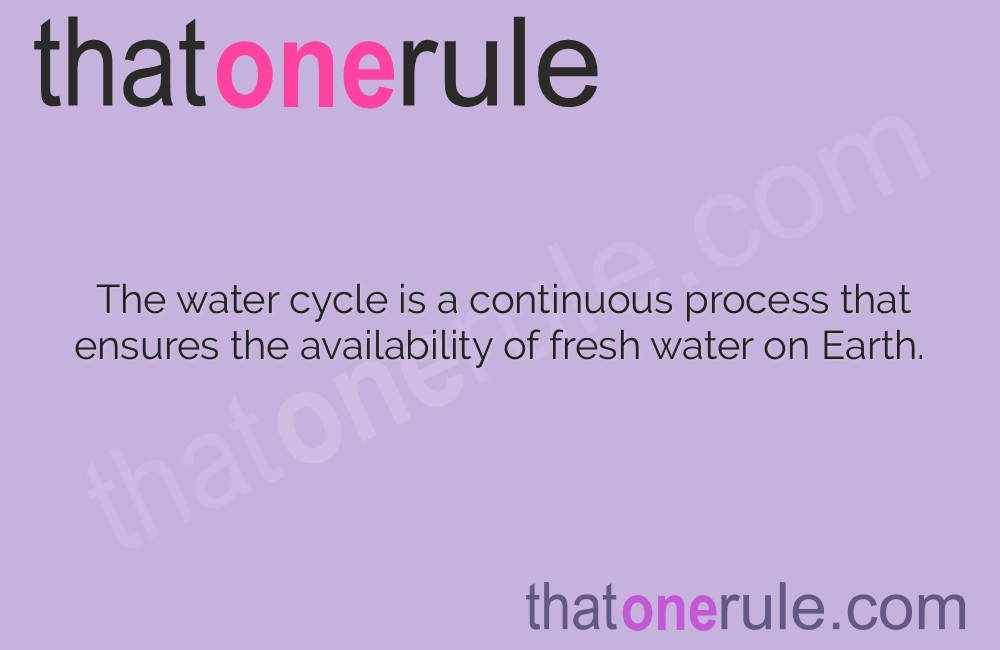Interesting Facts about the Water Cycle

The water cycle is a continuous process that ensures the availability of fresh water on Earth.
Water evaporates from oceans, lakes, and rivers and enters the atmosphere as water vapor.
Clouds are formed when water vapor condenses into tiny water droplets or ice crystals.
Precipitation occurs when clouds become saturated with water and water droplets fall to the ground as rain, snow, sleet, or hail.
The water cycle helps to distribute water across different regions and maintain the Earth’s natural balance.
About 97% of the Earth’s water is in the form of saltwater and only 3% is freshwater.
Water can stay in the atmosphere for an average of 9 days before it precipitates.
The process of evaporation is accelerated by heat, wind, and sunlight.
Water can also evaporate directly from plants through a process called transpiration.
The water cycle is crucial for agriculture as it provides water for crop growth and irrigation.
The process of condensation forms clouds that can be of different shapes and sizes.
Rainfall can be influenced by topography, wind patterns, and temperature gradients.
The water cycle helps to replenish underground water sources such as aquifers.
Water in the atmosphere can travel long distances before falling as precipitation.
The temperature at which water vapor condenses depends on factors such as air pressure and humidity.
Clouds can take various forms, including cumulus, stratus, and cirrus clouds.
Interesting Facts about the Water Cycle part 2
The water cycle plays a key role in maintaining the Earth’s climate and regulating global temperatures.
The majority of Earth’s freshwater is stored in ice caps, glaciers, and underground water sources.
The water cycle is essential for the survival of plants and animals, as they depend on freshwater for hydration.
The process of evaporation leads to cooling, which can help moderate the Earth’s temperature.
Rainfall patterns can vary in different regions, contributing to the diversity of ecosystems.
Water from rivers and streams eventually flows into oceans, completing the water cycle’s loop.
The water cycle is a fundamental concept in hydrology, the study of water on Earth.
The process of freezing water forms ice, which can then melt and contribute to the water cycle.
The water cycle also plays a role in shaping the Earth’s landscapes through erosion and sedimentation.
Water is a universal solvent, meaning it can dissolve various substances and transport them within the water cycle.
Changes in the water cycle can impact weather patterns, leading to droughts or floods.
The water cycle can be disrupted by human activities such as deforestation and pollution.
Water droplets in clouds can collide and merge, forming larger droplets that eventually fall as precipitation.
Fog is a type of cloud that forms at ground level due to condensation of water vapor.
The water cycle is a continuous exchange of water between the atmosphere, land, and oceans.
The water cycle helps to regulate the Earth’s energy balance by absorbing and releasing heat.
The process of condensation releases latent heat, which can contribute to the development of storms.
Evapotranspiration is the combined process of evaporation from the Earth’s surface and transpiration from plants.
The water cycle supports a variety of aquatic ecosystems, including rivers, lakes, and wetlands.
Water molecules can exist in three states: solid (ice), liquid (water), and gas (water vapor).
The water cycle is influenced by climate factors such as temperature and precipitation patterns.
Water is essential for all forms of life, and the water cycle ensures its continuous availability.
Water management and conservation play a crucial role in maintaining a sustainable water cycle.
The water cycle is part of the Earth’s larger system, which includes the atmosphere, hydrosphere, and biosphere.
The water cycle is a dynamic process that is constantly changing and adapting to environmental conditions.
Without the water cycle, Earth would be a barren, lifeless planet with no water available for living organisms.
The water cycle helps to regulate humidity levels in the atmosphere, influencing weather conditions.
The water cycle is a complex interplay between physical processes, energy transfer, and natural phenomena.
Understanding the water cycle is essential for addressing water-related challenges such as droughts, water scarcity, and climate change.
